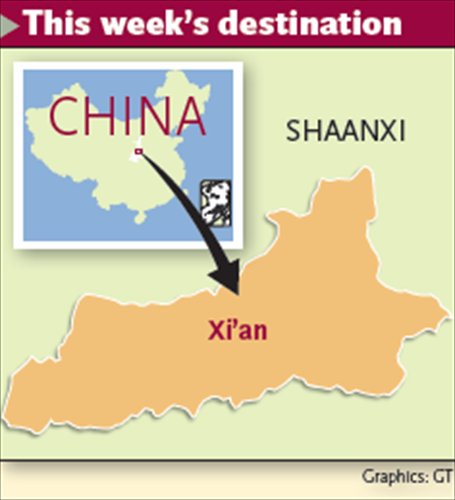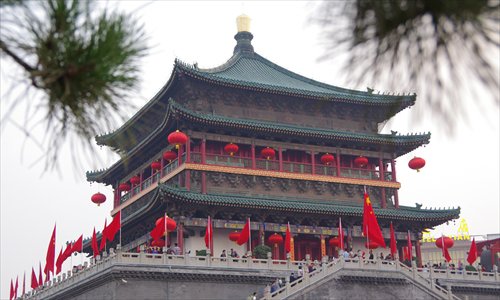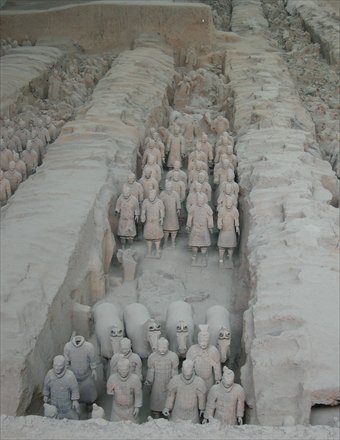Forever Shaanxi

This week's destination

The Bell Tower (above) and terracotta warriors (below) are some of the attractions on offer for tourists headed to China's ancient city of Xi'an in Shaanxi Province. Photos : IC and Peter Espina/GT

Shaanxi is one of the country's grand old provinces, where Chinese civilization first took shape. Nicknamed as China's "Eternal City," Xi'an was China's capital for several dynasties and boasts more history than Beijing, while the area's terracotta warriors are famous worldwide.
The province is also home to one of China's most famous mountains, Hua Mountain.
Yet, as foolish as it sounds, there was a time when I didn't care much for the place.
I thought that besides the terracotta warriors, there wasn't much else worth visiting. I was also indifferent to Hua Mountain, which I considered unattractive compared to Yellow Mountain in Anhui Province - and I was in no hurry to visit.
Xi'an, as many know, is where the terracotta army is located, having been buried in the tomb of Qinshihuang, China's first emperor and founder of the Qin Dynasty (221-206 BC) 2,300 years ago. From then, Xi'an's glory days continued until it reached its peak during the Tang Dynasty (618-907 AD), when it could lay claim to being one of the world's greatest cities. However, it then experienced a gradual decline until the 20th century, before farmers accidentally found a few of the terracotta warriors in 1974. Archaeologists unearthed many more terracotta figures and Xi'an resumed its place among the world's most famous cities. Rightfully so, going to see the terracotta warriors is a must. But Xi'an is about much more.
Ancient prestige
The city's downtown is marked by a fantastic sight straight out of ancient China - a large wooden tower with beautiful curved roofs standing atop a mighty stone base on a roundabout from which streets extend in four directions. A few minutes' walk away are the Bell Tower and Drum Tower, which you can go inside. During Imperial times, the bell in the former was rung to mark dawn while the latter marked dusk. Towering gray concrete malls and hotels topped with old-style curved tiled roofs loom like giant sentries along this intersection. Old and new coexist well in the center of Xi'an.
Right behind the Drum Tower is the Muslim Quarter. Filled with stores and restaurants in its many lanes, the bustling area is home to the city's Muslim Hui, who have lived in Xi'an ever since the Tang Dynasty. It's a great place to buy souvenirs, foodstuffs, and enjoy sizzling chuan (meat and vegetable skewers) and freshly baked naan bread on the street. You can also enjoy Shaanxi food such as the famous roujiamo (a Chinese-style "burger"), yangrou paomo (soup with goat meat and bread), and spicy biangbiang noodles.
The quarter also features the Great Mosque of Xi'an. Built over 1,250 years ago during the Tang Dynasty, it is a place of worship for local Muslims, with its peaceful grounds a contrast to all the shopping and tourism activity outside.
But, don't expect domes and minarets. The mosque's walls, pavilions, and main hall were built in ancient Chinese architectural style.
Xi'an's ancient prestige is a constant presence, because the downtown is completely surrounded by a giant wall, possibly the world's largest construction of its type, standing 12 meters tall and over 13 kilometers long. The wall is worth visiting, and if you don't want to spend hours walking on it, you can also ride a bicycle. The wall features main gates with defensive fortifications, guard towers every 120 meters, and interesting views of the city, with signs pointing out historical places.
The city's most famous temple might be the Big Wild Goose Pagoda, built in 652 to house Buddhist relics brought back by the explorer-monk Xuanzang from his travels along the Silk Road to India. Aesthetically, this pagoda tower isn't the most appealing with its bare brown exterior, but then, the main reason to visit is to appreciate its historical and religious significance. There's also a Little Wild Goose Pagoda, built in 707.
Good historical museums can be found in many Chinese cities and it's no different here when it comes to both the Shaanxi and Xi'an history museums, though I prefer the former. The Shaanxi museum was fantastic, showcasing a collection befitting the city's status. There were Tang Dynasty glazed pottery horses and camels, but the main attraction had to be real terracotta warriors. The terracotta warriors and horses are displayed inside a room surrounded by a chest-high barrier, almost within touching distance. The Shaanxi museum is near the Big Wild Goose Pagoda, while the Xi'an museum is next to the Small Wild Goose Pagoda, making it convenient to visit either.
Speaking of terracotta warriors, they're about an hour's ride away from Xi'an by bus on the city's outskirts. Housed in three main pits, most of the terracotta army is in a huge aircraft hangar-like building from which you can stare down at dozens of soldiers, horses, and chariots. It's an impressive sight, though don't be surprised to be a little underwhelmed. The two smaller pits feature much less figures, mostly in more original broken states with restoration still being done.
You can view terracotta figures and chariots up close in the onsite museum. Besides soldiers and officers, you can also see terracotta archers, acrobats and even animals. Qinshihuang's mausoleum is nearby, though it entails a 10-minute shuttle ride included in the entry ticket. Frankly, it was disappointing, being a small mound with the actual tomb inside and unable to be accessed.
A 'peak' at beauty
As one of China's five "Great Mountains," Hua Mountain has a hallowed place in Chinese history as the site of Imperial visits and Taoist pilgrimages, though this is less commonly known to the outside world. Yet search for the "world's most dangerous hike" on Google or Baidu, or on video-hosting websites like Youtube, and you'll see quite a few entries on Hua Mountain.
Close to Xi'an, just half an hour by high-speed rail, Hua Mountain is easy to get to. Upon arriving, I took the cable car instead of hiking to the top since I had my luggage as I had planned to stay atop the mountain for a night to allow myself more time to hike the trails on the peaks. It was rainy and overcast, but as the cable car ascended, I could clearly make out the looming mountain. When I arrived at North Peak, the shortest of Hua Mountain's five main peaks at 1,614 meters, I was faced with rocks, tourists and great views of neighboring mountains. In the distance, I saw the vertical "Green Dragon Ridge" staircase that leads to the higher peaks, and West Peak with its distinctive hump.
I checked into a hotel at North Peak, choosing the 16-bed dorm since the personal room was a budget-busting 600 yuan ($98) per night. With the toilet in a block outside the hotel and no running water, it certainly wasn't luxury accommodation. Putting all that aside, it was time to explore.
First, I went up the narrow Green Dragon Ridge that connects North Peak to the rest of Hua Mountain. Reaching the top takes you to Gold Lock Pass, featuring a massive gold lock, along with hundreds of locks tied to staircases with flowing red ribbons for luck in relationships or work. These locks are a common sight on Hua Mountain.
Hua Mountain has five main peaks. The mountain is shaped like a four-sided flower with North Peak detached from the others. Initially, there's a lot of stair-climbing and you'll often pass porters carrying heavy loads on poles slung across their shoulders slowly making their way up - how all the food, drinks, and building materials reach the top. Occasionally, hikers handed bottled drinks to these porters, affirming that random kindness exists in China.
I was wrong to think that Hua Mountain was unattractive; its stark bare mountainside and sheer cliffs gave it a dignified beauty that is often featured in Chinese landscape paintings. While some parts were rocky, there were pine forests on the higher peaks. There were several small shrines all over the mountain, with a few even built into boulders. It was easy to understand why pilgrims and hermits had come here since time immemorial.
West Peak is where you watch the sunset, as I did; East Peak is where you watch the sunrise, which many people hike overnight to do. Central Peak is surrounded by East and South Peaks and isn't particularly interesting.
South Peak is Hua Mountain's highest at 2,154.9 meters, and it's also where the most dangerous paths are. One of them involves crawling down a cliff, while the other one is a walk along a very narrow plank with no barrier between you and the edge. Luckily, you don't need to hike these paths, but if you choose to, you have to pay a fare and wear a harness, a rule implemented after fatal accidents in the past. I passed on the chance, which I do regret a little now.
Each main peak has hostels, vendors and bathrooms, but most are without running water. The paths are well marked and though steep at some parts, they are manageable. I reached all five peaks and left exhausted, but with a full appreciation of Hua Mountain.
I had also felt a similar sense of fondness for Xi'an when I departed the city earlier. Turns out, there is much more to Shaanxi than just some army of old clay figures.
Rules of Thumb
How to go: To get to Xi'an, take the high-speed rail from Beijing or Zhengzhou, or fly from numerous cities, such as Hong Kong, Beijing and Shanghai. For Hua Mountain, go by high-speed rail from Xi'an or Zhengzhou, or take a regular train or bus from Xi'an.
Where to stay: Xi'an has plenty of hotels and hostels in the city center. Choose one near the Bell Tower and Drum Tower for the most convenience. At Hua Mountain, there is a hotel on North Peak, hostels on various other peaks and hotels in the adjacent city of Huayin.
When to visit: The most pleasant time of year to visit Xi'an is from the city's spring from March to May and its autumn in September and October. Climb Hua Mountain from April to October though be wary of rainy and cloudy seasons. Braving the cold in winter could pay off with a view of snow-capped peaks.